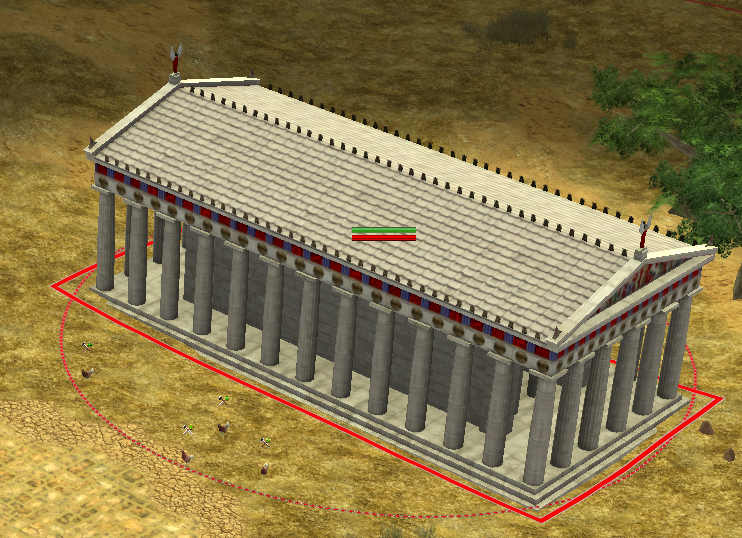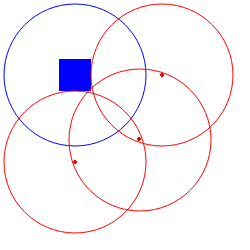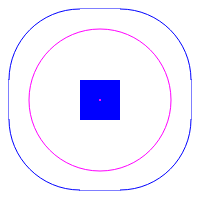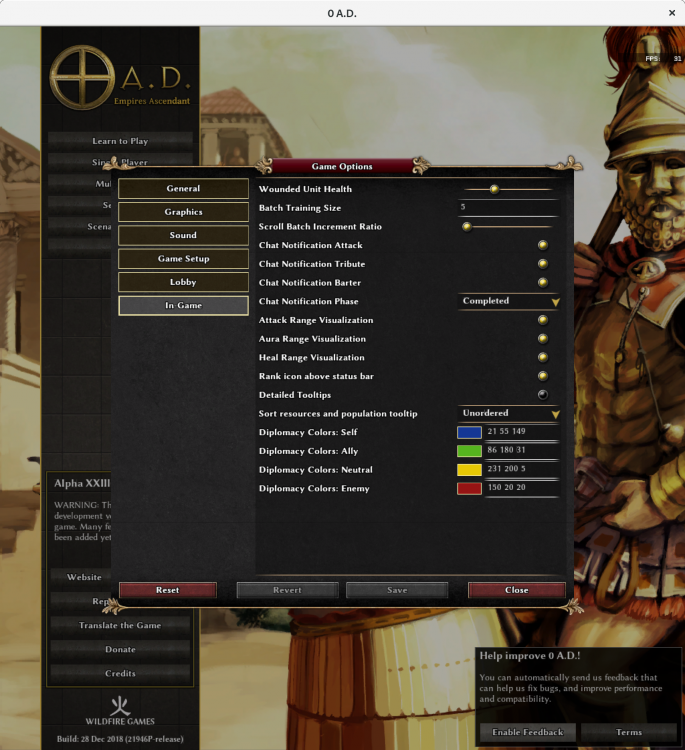-
Posts
2.300 -
Joined
-
Days Won
23
Posts posted by Nescio
-
-
Yes, people come and go, which is perfectly fine. But if more people leave than join in the long run, then the project's doomed. And yes, the review backlog is also problematic.
-
 1
1
-
-
17 hours ago, stanislas69 said:
That's in my todo list, however it's a pretty boring task, so it's not high priority.
It might be tedious, but it is something that will be useful for factions and mods beyond 0 A.D.'s timeframe.
Ideally there ought to be the following (41) sizes for both rubble and foundations:
(1) for towers:
1x1(25) for ordinary structures:
2x2, 2x3, 2x4, 2x5, 2x6,
3x2, 3x3, 3x4, 3x5, 3x6,
4x2, 4x3, 4x4, 4x5, 4x6,
5x2, 5x3, 5x4, 5x5, 5x6,
6x2, 6x3, 6x4, 6x5, 6x6.(15) for wonders:
—, 6x8, 6x10, 6x12,
8x6, 8x8, 8x10, 8x12,
10x6, 10x8, 10x10, 10x12,
12x6, 12x8, 12x10, 12x12.Currently existing rubble (`destruct_stone_`): 2x2, 3x3, 4x2, 4x4, 4x6, 5x5, 6x4, 6x6 (8)
Currently existing foundations (`fndn_`): 1x1, 2x2, 2x4, 3x3, 3x6, 4x2, 4x4, 4x6, 5x5, 6x4, 6x6, 8x8 (12)
[EDIT]: approximate wonder sizes: athen 6x12, brit 11x11, cart 6x12, gaul 11x11, iber 8x8, kush 9x12, mace 6x12, maur 11x11, pers 12x12, ptol 9x12, rome 8x10, sele 6x12, spart 7x12.
-
3 hours ago, Sundiata said:
(chariotry was still around in the 500 BC - 1 BC timeframe, but not as common as it once was).
Chariotry and cavalry coexisted for centuries.
1 hour ago, av93 said:I could also give the "Libyan" chariot a go. Just to be clear, do you mean Libyan, or Garamantian chariot? https://africanrockart.britishmuseum.org/thematic/chariots-in-the-sahara/
Libyan, although Libya could be applied to basically everything west of Egypt. Presumably their chariots followed basically the same design as the Bronze Age Egyptian chariots.
Herodotus mentions Xerxes' army included Libyan (and Indian) chariots:
Quote[86] Τούτων μὲν αὕτη ἡ μάχη, καὶ ἐπετετάχατο ἐς τοὺς Πέρσας· Μῆδοι δὲ τήν περ ἐν τῷ πεζῷ εἶχον σκευήν, καὶ Κίσσιοι ὡσαύτως. Ἰνδοὶ δὲ σκευῇ μὲν ἐσεσάχατο τῇ αὐτῇ καὶ ἐν τῷ πεζῷ, ἤλαυνον δὲ κέλητας καὶ ἅρματα· ὑπὸ δὲ τοῖσι ἅρμασι ὑπῆσαν ἵπποι καὶ ὄνοι ἄγριοι. Βάκτριοι δὲ ἐσκευάδατο ὡσαύτως καὶ ἐν τῷ πεζῷ, καὶ Κάσπιοι ὁμοίως. Λίβυες δὲ καὶ αὐτοὶ κατά περ ἐν τῷ πεζῷ· ἤλαυνον δὲ καὶ οὗτοι πάντες ἅρματα. ὣς δ᾿ αὕτως Κάσπιοι καὶ Παρικάνιοι ἐσεσάχατο ὁμοίως καὶ ἐν τῷ πεζῷ. Ἀράβιοι δὲ σκευὴν μὲν εἶχον τὴν αὐτὴν καὶ ἐν τῷ πεζῷ, ἤλαυνον δὲ πάντες καμήλους ταχυτῆτα οὐ λειπομένας ἵππων.
[86] This is their manner of fighting; their place in the army was with the Persians. The Median horse were equipped like their foot, and the Cissians likewise. The Indians were armed in like manner as their foot; they rode swift horses and drove chariots drawn by horses and wild asses. The Bactrians were equipped as were their foot, and the Caspians in like manner. The Libyans too were armed like the men of their infantry, and all of them too drove chariots. So likewise the Caspians and Paricanians were armed as the men of their infantry. The Arabians had the same equipment as the men of their infantry, and all of them rode on camels no less swift than horses.
— Herodotus VII.86; text and translation A. D. Godley (1922)
And their weapons:
Quote[65] Ἰνδοὶ δὲ εἵματα μὲν ἐνδεδυκότες ἀπὸ ξύλων πεποιημένα, τόξα δὲ καλάμινα εἶχον καὶ ὀιστοὺς καλαμίνους· ἐπὶ δὲ σίδηρος ἦν. ἐσταλμένοι μὲν δὴ ἦσαν οὕτω Ἰνδοί, προσετετάχατο δὲ συστρατευόμενοι Φαρναζάθρῃ τῷ Ἀρταβάτεω.
[65] The Indians wore garments of tree-wool [cotton], and carried bows of reed and iron-tipped arrows of the same. Such was their equipment; they were appointed to march under the command of Pharnazathres son of Artabates.
[...]
[70] Τῶν μὲν δὴ ὑπὲρ Αἰγύπτου Αἰθιόπων καὶ Ἀραβίων ἦρχε Ἀρσάμης, οἱ δὲ ἀπὸ ἡλίου ἀνατολέων Αἰθίοπες (διξοὶ γὰρ δὴ ἐστρατεύοντο) προσετετάχατο τοῖσι Ἰνδοῖσι, διαλλάσσοντες εἶδος μὲν οὐδὲν τοῖσι ἑτέροισι, φωνὴν δὲ καὶ τρίχωμα μοῦνον· οἱ μὲν γὰρ ἀπὸ ἡλίου Αἰθίοπες ἰθύτριχες εἰσί, οἱ δ᾿ ἐκ τῆς Λιβύης οὐλότατον τρίχωμα ἔχουσι πάντων ἀνθρώπων. οὗτοι δὲ οἱ ἐκ τῆς Ἀσίης Αἰθίοπες τὰ μὲν πλέω κατά περ Ἰνδοὶ ἐσεσάχατο, προμετωπίδια δὲ ἵππων εἶχον ἐπὶ τῇσι κεφαλῇσι σύν τε τοῖσι ὠσὶ ἐκδεδαρμένα καὶ τῇ λοφιῇ· καὶ ἀντὶ μὲν λόφου ἡ λοφιὴ κατέχρα, τὰ δὲ ὦτα τῶν ἵππων ὀρθὰ πεπηγότα εἶχον· προβλήματα δὲ ἀντ᾿ ἀσπίδων ἐποιεῦντο γεράνων δοράς.
[70] The Ethiopians above Egypt [Kush] and the Arabians had Arsames for commander, and the Ethiopians of the east (for there were two kinds of them in the army) served with the Indians; they differed nothing in appearance from the others, but only in speech and hair; for the Ethiopians from the east are straight-haired, but they of Libya have of all men the woolliest hair. These Ethiopians of Asia were for the most part armed like the Indians; but they wore on their heads the skins of horses’ foreheads, stripped from the head with ears and mane; the mane served them for a crest, and they wore the horses’ ears stiff and upright; for shields they had bucklers of cranes’ skin.
[71] Λίβυες δὲ σκευὴν μὲν σκυτίνην ἤισαν ἔχοντες, ἀκοντίοισι δὲ ἐπικαύτοισι χρεώμενοι, ἄρχοντα δὲ παρείχοντο Μασσάγην τὸν Ὀαρίζου.
[71] The Libyans came in leathern garments, using javelins of charred wood. Their commander was Massages son of Oarizus.
— Herodotus VII.65, 70, 71; text and translation A. D. Godley (1922)
-
Things I'd like to include in my mod if someone (@Alexandermb, @LordGood, @stanislas69, anyone else?) could create them for me:
- Seleucid palace
- Roman rotary mill
- Gaul infantry archer (b/a/e)
- Libyan infantry pikeman (b/a/e) [Cart]
- Libyan infantry javelinist (b/a/e) [Cart]
- Numidian infantry javelinist mercenary (b/a/e) [Rome]
-
bigae (light two-horse chariot):
- Kushite biga archer champion [Kush]
- Libyan biga archer mercenary (b/a/e) [Cart]
- Libyan biga javelinist mercenary (b/a/e) [Cart, Pers]
- long and narrow field plots with a 1:10 width:depth ratio, e.g. 9×90 footprint instead of current 28×28
- rubble/destruct_stone_{2x4, 2x3, 3x2, 3x4, 4x3} (4x2 already exists)
- foundation/fndn_{2x3, 3x2, 3x4, 4x3, 6x3} (3x6 already exists) and {8x10, 8x12, 10x8, 10x10, 10x12, 12x8, 12x10, 12x12} (for wonders)
-
1 hour ago, fatherbushido said:
It's completely different.
UnitAI places unit at range (so taking into account obstruction of the target) (high cost).
BuildingAI do a range query from center to center and fire all things in that range (low cost).
What if an unit has both?
-
33 minutes ago, nani said:
I would expect 3x-5x times more expensive than the current circle implementation.
Doesn't sound too bad.
4 minutes ago, fatherbushido said:(Then there is a difference for attacks performed by BuildingAI and the ones performed by UnitAI.)
BuildingAI fires in any direction and can have multiple arrows, UnitAI attacks only forward, or are there other differences?
-
The default fortress has a footprint of 30×30, which means its range ought to be increased by √(15²+15²)≈21 in order to be able to hit archers; the Roman centre has a footprint of 40×40, thus requiring a range increase of √(20²+20²)≈28. However, bolt shooters and stone throwers have a MaxRange of only 80.
Speaking of which, structures need a vision range of at least (structure footprint radius + siege weapon range), otherwise they won't be able to see their attackers.
Ideally, ranges (attack, aura, heal, vision) ought to be calculated from the footprint instead of its centre. Then entities with the same MaxRange will always be able to attack each other, regardless of their size, and melee units can simply have a MaxRange of 1 (right now the siege ram has a MaxRange of 6.5, because the Macedonian and Roman rams have a footprint length of 12). However, I guess that's difficult to implement and might affect performance as well (a circle is a simple shape).
For comparison, MaxRange from footprint (blue) and from centre (magenta):
It would also solve things like this:

-
 3
3
-
-
Currently structures and archers have a MaxRange of 72. Because attacks go from centre to edge, this means archers (red) can hit centres or fortresses (blue) without those being able to shoot back:

-
 2
2
-
-
25 minutes ago, fatherbushido said:
No I don't. I will write the thing if you want.
Yes, I don't quite understand how it works, therefore a lengthier explanation would be appreciated.
-
 1
1
-
-
47 minutes ago, fatherbushido said:
the hypothenuse of the new triangle - not the horizontal range
Do you mean TotalRange² = MaxRange² + ElevationBonus² ?
-
On 2/24/2019 at 3:36 PM, fatherbushido said:
It's the height added to the terrain height.
Yes, I assumed so; but what's the result exactly? E.g. do the following give effectively different results?
- 80 max range + 0 elevation bonus
- 40 max range + 40 elevation bonus
- 0 max range + 80 elevation bonus
By the way, the range visualization seems to ignore the elevation bonus; is that intentional?
-
How many different shield shapes do you have and how many pattern colourings for each?
Which ones will be used by the Britons and which ones by the Gauls?
-
2 hours ago, fatherbushido said:
The other things is does it make sense to train a trireme on a river or not?
The Romans used liburnians on the Lower Rhine and Danube, but not triremes or larger polyremes.
-
13 minutes ago, Phalanx said:
if they have proper equipment like a saddle and stirrups
Stirrups did not yet exist in our timeframe.
-
 1
1
-
-
57. How does elevation bonus work exactly?
I've given template_structure_defensive_tower.xml a <MaxRange> of 18 and an <ElevationBonus> of 6. The outpost has both multiplied by 2.0, the small tower by 3.0, the large tower by 4.0, so I'd expect their respective ranges to be 36+12, 54+18, and 72+24; instead, they show up as 36+10, 54+16, and 72+21.
Furthermore, the siege tower has 60+10 in my mod, but it shows up as 60+9.
-
Xenophon wrote a short treatise on horsemanship, which is worth reading. Here are some excerpts where he mentions the manes:
Quote[7] καὶ οὐρὰν δὲ καὶ χαίτην πλύνειν χρή, ἐπείπερ αὔξειν δεῖ τὰς τρίχας, τὰς μὲν ἐν τῇ οὐρᾷ, ὅπως ἐπὶ πλεῖστον ἐξικνούμενος ἀποσοβῆται ὁ ἵππος τὰ λυποῦντα, τὰς δὲ ἐν τῷ τραχήλῳ, ὅπως τῷ ἀναβάτῃ ὡς ἀφθονωτάτη ἀντίληψις ᾖ. [8] δέδοται δὲ παρὰ θεῶν καὶ ἀγλαΐας ἕνεκεν ἵππῳ χαίτη, καὶ προκόμιον δὲ καὶ οὐρά. τεκμήριον δέ: αἱ γὰρ ἀγελαῖαι τῶν ἵππων οὐχ ὁμοίως ὑπομένουσι τοὺς ὄνους ἐπὶ τῇ ὀχείᾳ ἕως ἂν κομῶσιν: οὗ ἕνεκα καὶ ἀποκείρουσι πρὸς τὴν ὀχείαν τὰς ἵππους ἅπαντες οἱ ὀνοβατοῦντες.
[7] He should also wash the tail and mane, for growth of the tail is to be encouraged in order that the horse may be able to reach as far as possible and drive away anything that worries him, and growth of the mane in order to give the rider as good a hold as possible. [8] Besides, the mane, forelock and tail have been given to the horse by the gods as an ornament. A proof of this is that brood mares herding together, so long as they have fine manes, are reluctant to be covered by asses; for which reason all breeders of mules cut off the manes of the mares for covering.
— Xenophon On Horsemanship 5.7–8, text and translation by E. C. Marchant (1925)
Quoteὅταν γε μὴν παραδέξηται τὸν ἵππον ὡς ἀναβησόμενος, νῦν αὖ γράψομεν ὅσα ποιῶν ὁ ἱππεὺς καὶ ἑαυτῷ καὶ τῷ ἵππῳ ὠφελιμώτατος ἂν ἐν τῇ ἱππικῇ εἴη. πρῶτον μὲν τοίνυν τὸν ῥυταγωγέα χρὴ ἐκ τῆς ὑποχαλινιδίας ἢ ἐκ τοῦ ψαλίου ἠρτημένον εὐτρεπῆ εἰς τὴν ἀριστερὰν χεῖρα λαβεῖν, καὶ οὕτω χαλαρὸν ὡς μήτ᾽ ἂν ἀνιὼν τῶν τριχῶν παρὰ τὰ ὦτα λαβόμενος μέλλῃ ἀναβήσεσθαι μήτ᾽ ἂν ἀπὸ δόρατος ἀναπηδᾷ, σπᾶν τὸν ἵππον. τῇ δεξιᾷ δὲ τὰς ἡνίας παρὰ τὴν ἀκρωμίαν λαμβανέτω ὁμοῦ τῇ χαίτῃ, ὅπως μηδὲ καθ᾽ ἕνα τρόπον ἀναβαίνων σπάσῃ τῷ χαλινῷ τὸ στόμα τοῦ ἵππου.
We will now describe what the rider should do when he has received his horse and is going to mount, if he is to make the best of himself and his horse in riding.
First, then, he must hold the lead-rope fastened to the chin-strap or the nose-band ready in the left hand, and so loose as not to jerk the horse whether he means to mount by holding on to the mane near the ears or to spring up with the help of the spear. With his right hand let him take hold of the reins by the withers along with the mane, so that he may not jerk the horse's mouth with the bit in any way as he mounts.
— Xenophon On Horsemanship 7.1, text and translation by E. C. Marchant (1925)
Quoteτάφρον δὲ διαλλομένου καὶ πρὸς ὄρθιον ἱεμένου καλὸν χαίτης ἐπιλαμβάνεσθαι, ὡς μὴ ὁ ἵππος τῷ τε χωρίῳ ἅμα καὶ τῷ χαλινῷ βαρύνηται. εἴς γε μὴν τὸ πρανὲς καὶ ἑαυτὸν ὑπτιώτερον ποιητέον καὶ τοῦ ἵππου ἀντιληπτέον τῷ χαλινῷ, ὡς μὴ προπετῶς εἰς τὸ κάταντες μήτε αὐτὸς μήτε ὁ ἵππος φέρηται.
When jumping a ditch or riding up hill it is well to take hold of the mane, that the horse may not be burdened by his bridle and the difficulty of the ground at the same time. When going down a steep incline, he should throw his body back and support the horse with the bridle, that neither rider nor horse may be tossed headlong down hill.
— Xenophon On Horsemanship 8.8, text and translation by E. C. Marchant (1925)
-
 2
2
-
 2
2
-
-
6 hours ago, Anaxandridas ho Skandiates said:
You do not seem to want help at all, you just seem to be right with your wikipedia-knowledge.
Actually I do not claim to be always right – nobody is – but when I see something I believe is incorrect I feel obliged to respond. If you look at my posts, you'll see I didn't quote Wikipedia.
Let's take a step back. I believe we agree on most points:
- θ, φ, χ were pronounced /tʰ pʰ kʰ/, respectively, not /θ f x/; we also agree on the other consonants
- ο and ω were different sounds
- a number of sound shifts occurred in Hellenistic times (e.g. iotacism)
- ου was eventually pronounced /u/
The thing we seem to disagree about is the Classical Attic pronunciation of 〈ει〉 and 〈ου〉. I provided a number of arguments (Plato, LSJ, epigraphy, comparative linguistics) why I believe they were (still) pronounced /eː/ and /oː/. However, I don't think I'll be able to convince you; you seem to be entrenching yourself without providing real arguments; which is your good right.
The fiercest discussions are typically on minor issues. I believe this one to be no exception.
Personally I don't care how people pronounce Greek. If people want to pronounce 〈φ〉 and 〈ου〉 as /f/ and /u/ that's perfectly fine; in fact, I do so myself, because the purpose of language is to be understood, and to a modern audience /pʰ/ and /oː/ often sound indistinguishable from /p/ and /o/.
2 hours ago, GunChleoc said:How about we table the IPA discussion for now and focus on the correct transliteration of the specific names first, so that some work can be accomplished? Pronunciation notes can come later for the voices list.
Well, we all agree on that, don't we?
-
 1
1
-
3 hours ago, Anaxandridas ho Skandiates said:
We need to decide on a reasonably informed system to transliterate unit and building names in the game, not decide the eternal truth.
How to transcribe Greek into the Latin alphabet is a separate discussion that belongs elsewhere. The purpose of transliteration is to stay as close as possible to how something was written; the purpose of IPA is to stay as close as possible to how something was pronounced. The exact pronunciation of Greek is irrelevant for the transliteration of Greek discussion.
3 hours ago, Anaxandridas ho Skandiates said:time to record some Greek for us to prove it then, right?
Perhaps it's better if you record how you think the Greek vowels ought to be pronounced and then ask @GunChleoc to convert your audio into IPA. As has been pointed out before, looking for English equivalents is problematic.
3 hours ago, Anaxandridas ho Skandiates said:But I will say this: You @Nescio are here defending your position by simply repeating what you wrote in the previous post, that ΟΥ is not corresponding to 'u'
Although 〈ου〉 became /u/ in Hellenistic times, it was indeed not yet pronounced so in Classical Attic.
The fact that Plato and others call 〈ο〉 οὖ indicates they were the same sound, i.e. /ο/; mutatis mutandis for 〈ε〉 εἶ /e/; feel free to look it up in your LSJ.
Another argument is to compare Attic inscriptions with Attic literary texts after the spelling reform of 403 BC, e.g. EXΟΣΙΝ = ἔχουσιν, ΕΠΕΣΤΑΤΕ = ἐπεστάτει.
We could also look at spelling differences between Ionic and Attic: Ion. ξεῖνος / Att. ξένος; Ion. μοῦνος / Att. μόνος; Ion. οὐδός / Att. ὀδός.
Or one could look up how these spurious diphthongs emerged. Answer: by compensatory lengthening; e.g.:
PIE *h₁e-men-sm̥ → *emenha → emē ̣na = Ionic/Attic ἔμεινα
Doric ἄγοντι → *ἄγονσι → Attic/Ionic ἄγουσιAll of this indicates that 〈ει〉 was the spelling of /eː/ and 〈ου〉 was /oː/ in 4th C BC Attic.
3 hours ago, Anaxandridas ho Skandiates said:The letters were not even the same for each region and the dialects, but you will find large charts showing all the countless variants.
Yes, I'm fully aware of that. There were dozens of Greek alphabets, not yet a single one; nor were Etruscan, Latin, and other Italic scripts different alphabets.
3 hours ago, Anaxandridas ho Skandiates said:ΟΥΡΑΝΙΑ=Uranía
ΧΕΙΡΩΝ=Cheírôn
[...] For this is not a settled matter, but I think that writing "Cherôn" and "Orania" is an inferior solution, and dare to state this opinion here.Again, the transliteration of Greek is a different issue from the pronunciation. E.g. Ἀθῆναι is Latinized as Athenae and Anglicized as Athens; its Classical pronunciation was /atʰɛ̂ːnai̯/, its modern is /aˈθina/.
-
 1
1
-
-
7 hours ago, Thorfinn the Shallow Minded said:
Finally someone understands my pain.

?
11 hours ago, coworotel said:Maybe you wanna take a look at /gui/reference/structree/draw.js. I was trying to make a mod to increase the size of the icons in the techtree screen and it was surprisingly hard to do. There's a lot of things hard-coded there. If I recall correctly the number of phases there is hard-coded to 3 as well. Good luck!
Modifying the GUI is time consuming and frustrating; I was hoping to avoid it.
5 hours ago, wowgetoffyourcellphone said:Are you sure? Delenda Est quite easily displays 4 phases in structree.
The difference is Delenda Est has a fourth phase for all factions, whilst I want it only for three.
-
18 minutes ago, mimo said:
but still, when you say that things work or don't work, does that mean that it does what you want in game, or the structree works? Making it work in game should be straightforward (with what you describe, having only generic phases, with the wanted civ requirements in the phase_metropolis_generic.json).
But as i said, i think the structree is broken when civs don't have the same phase sequences (it does not check for civ req when building the phaseList, and there is only one phaseList for all civs).
When I say something doesn't work, I mean it causes errors. And yes, it seems the problem is primarily with the structree. It did work in A22, though.
-
On 2/18/2019 at 8:53 PM, Thorfinn the Shallow Minded said:
Do you plan to have any way to toggle the aura indicators on and off? It could make a group of units look fairly cluttered without that option.
What do you mean exactly? Those visualizations are already optional:
On 2/18/2019 at 8:53 PM, Thorfinn the Shallow Minded said:Also, do you mind sharing the reasons that you removed Athens and Sparta in favour of a single faction while keeping the Celts the same (Not to sound is if I consider the approach you have taken to be inferior to what the official game has to offer.)?
To start with, if Athens and Sparta, then why not Argos, Corinth, Thebes, Syracusae, etc. as well? Gauls are not split up in multiple separate tribes either, nor are Britons or Iberians.
Secondly, popular culture typically exaggerates the differences between Athens and Sparta. Sure, there were some differences, but overal they were more similar than most people realize. Their armies consisted of a core of heavily armed but untrained wealthy citizens, supplemented by hired mercenaries and coerced allies. In democratic Athens, c. 10% of the population could vote, but the politicians addressing the people, making proposals and speeches, and getting nominated and elected to the highest offices (archons and strategoi) came from a handful of oligarchic families. Sparta was officially a dual monarchy (its kings were comparable to Roman consuls or Carthaginian sufets) but the real political power was in the hands of the oligarchic gerousia (senate). Farming was the primary occupation. They recognized the same pantheon. Etc.
Furthermore, Athenians and Spartans have rather similar unit rosters; Sparta has an architecture set of its own, while Athens heavily borrows from the Macedonian actors.
-
On 2/16/2019 at 3:40 PM, mimo said:
reading previous posts, i'm unable to say what you really want to achieve and what does not work.
Basically what I want is the following:
phase_village.json (autoresearched)
phase_town.json (all civs)
phase_city.json (all civs)
phase_metropolis.json (mace, ptol, sele; not any other civs)What I currently have is:
phase_village.json
phase_town.json
phase_town_generic.json
phase_town_athen.json.DELETED
phase_city.json
phase_city_generic.json
phase_city_athen.json.DELETEDWhat works is the above with:
phase_metropolis.json (placeholder)
phase_metropolis_generic.json (no civ requirements)
phase_metropolis_mace.json
phase_metropolis_ptol.json
phase_metropolis_sele.jsonThings that don't work include:
phase_metropolis.json (mace, ptol, sele requirements)
phase_metropolis.json (placeholder)
phase_metropolis_generic.json (mace, ptol, sele requirements)phase_metropolis.json (placeholder)
phase_metropolis_mace.json
phase_metropolis_ptol.json
phase_metropolis_sele.jsonFurthermore, I have no idea why the following causes errors:
phase_village.json
phase_town.json
phase_town_generic.json.DELETED
phase_town_athen.json.DELETED
phase_city.json
phase_city_generic.json.DELETED
phase_city_athen.json.DELETED-
 1
1
-
-
It's best to avoid English when approximating sounds, because English orthography is horrible and because English phonology varies greatly between different dialects. The classical pronunciatition of ω is /ɔː/; if you do want English equivalents, I'd say it's the sound as in more or saw (Received Pronunciation), not slow /sloʊ/.
Unless otherwise stated, Classical Greek means 4th C BC Attic prose, the language of Lysias, Plato, and Xenophon. There were quite a few sound shifts later in Hellenistic times:
α, ᾳ → /a/
ε → /e/
ει, η, ῃ, ι, οι, υ, υι → /i/
ο, ω, ῳ → /o/
ου → /u/
β → /v/It is important to realize e-psilon, o-micron, u-psilon, and o-mega are modern names; in Classical times they were called εἶ, οὖ, ὖ, and ὦ, respectively (other letters already had their current names); e.g.:
Quote[Σωκράτης] ὧν γ᾽ ἔστιν ἓν καὶ ‘τέχνην’ ἰδεῖν ὅτι ποτὲ βούλεται εἶναι.
Socrates: One of which is to see what the word τέχνη (art, science) means.[Ἑρμογένης] πάνυ μὲν οὖν.
Hermogenes: Certainly.[Σωκράτης] οὐκοῦν τοῦτό γε ἕξιν νοῦ σημαίνει, τὸ μὲν ταῦ [414c] ἀφελόντι, ἐμβαλόντι δὲ οὖ μεταξὺ τοῦ χεῖ καὶ τοῦ νῦ καὶ τοῦ νῦ καὶ τοῦ ἦτα;
Socrates: Does not this denote possession of mind, if you remove the tau and insert omicron between the chi and the nu and the nu and the eta (making ἐχονόη)?— Plato Cratylus 414b–c
[EDIT]: In short, ε was /e/, ει was /eː/, η was /ɛː/, ο was /o/, ου was /oː/, and ω was /ɔː/ in Classical Greek.
-
 1
1
-
 1
1
-
-
4 minutes ago, Thorfinn the Shallow Minded said:
All of these are done very well. One criticism I have is for the Falcata. The proportion of the blade length to the hilt makes it seem more like a hunting knife than a sword. The reproduction I have seen are generally much longer than what you have. That said, I am no expert on the subject and if you have any good reference for why you made it so short I would appreciate it. Even that issue is quite minor; again excellent work.
Well, I'm not an archaeologist either, but it was certainly not a hunting knife; the Iberian falcata is basically equivalent with a Greek makhaira; here's an original:
_01b.jpg.3b368457e755afb5afe81719593c81e4.jpg)
(Description says 4th C BC, length 53.1 cm (20.9″).)





State of the AI
in General Discussion
Posted
Thank you for your dramatic response. To clarify, I didn't intend to complain, nor am I saying 0 A.D. is doomed; what I wrote was “if”.
I too have observed this project grow and improve over the years, which is likely to continue for years to come. Personally I don't care how fast or slow development is; it's already a great game and can only get better!
I don't know what could – or should – change, but I do hope new people will come and join the project eventually; having two dozen people who do a little is preferable to a situation where one person does so much he's become irreplaceable.